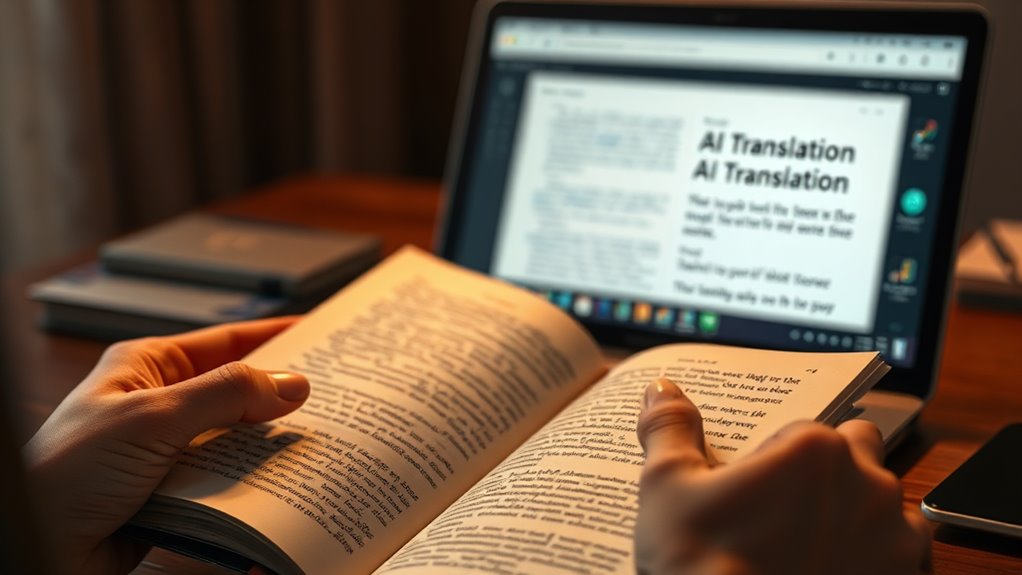Dịch thuật AI và dịch thuật viên con người hiện đều có vị trí quan trọng trong ngành ngôn ngữ.
Mỗi phương pháp mang lại những lợi thế riêng biệt tùy theo tính chất và yêu cầu của từng dự án. Tuy nhiên, việc lựa chọn giải pháp phù hợp không đơn giản chỉ dựa vào chi phí hay tốc độ.
Vấn đề còn nằm ở khả năng truyền tải ý nghĩa sâu sắc và chính xác trong từng ngữ cảnh cụ thể.
Để đáp ứng nhu cầu dịch thuật phụ đề video và lồng tiếng chuyên nghiệp, DichThuatVideo.com mang đến dịch vụ làm phụ đề và lồng tiếng thế hệ mới, kết hợp sức mạnh của AI và trí tuệ của chuyên gia.
Chúng tôi khai thác công nghệ để tăng tốc độ và tối ưu chi phí, giúp khách hàng trải nghiệm dịch vụ dịch thuật video nhanh hơn, thông minh hơn.
Thông tin liên hệ Zalo/SMS: 0981.243.678 | Website: dichthuatvideo.com
Những điểm chính
- Chọn dịch thuật AI khi cần tốc độ cao và chi phí thấp cho tài liệu khối lượng lớn, nội dung chung.
- Dịch thuật viên con người phù hợp với tài liệu yêu cầu độ chính xác cao, sắc thái văn hóa và cảm xúc tinh tế.
- Tài liệu kỹ thuật hoặc nhạy cảm nên dùng dịch thuật viên con người để đảm bảo chuyên môn và bảo mật.
- Dịch thuật AI thiếu khả năng truyền tải tông điệu, cảm xúc và ngữ cảnh phức tạp, cần con người hiệu chỉnh.
- Dịch thuật viên con người thích hợp khi cần phong cách linh hoạt, điều chỉnh theo đối tượng và mục đích cụ thể.
Tổng quan về dịch thuật AI và dịch thuật viên con người

Although both AI translation and human translation aim to convert text from one language to another, they differ fundamentally in approach and execution. AI translation relies on machine learning algorithms and vast linguistic datasets to generate translations automatically. These systems analyze patterns and statistical probabilities to produce immediate results without human intervention. In contrast, human translation involves skilled translators who understand cultural nuances, idiomatic expressions, and contextual subtleties. They apply critical thinking and creativity to guarantee accuracy and natural flow. While AI excels in speed and handling large volumes, human translators provide deeper comprehension and adaptability, especially in complex or specialized content. Both methods have distinct workflows, tools, and limitations, influencing their suitability for different projects. Understanding these core differences helps in selecting the appropriate translation method based on the specific requirements of accuracy, context, and turnaround time.
Ưu điểm của dịch thuật AI trong các dự án dịch thuật
When handling large-scale translation projects, AI translation offers significant advantages in speed and efficiency. AI systems can process vast volumes of text rapidly, reducing turnaround times and lowering costs. In addition, AI tools maintain consistent terminology across documents, enhancing uniformity. They are available 24/7, supporting urgent and continuous translation needs without fatigue. Moreover, AI easily integrates with other digital workflows, streamlining project management.
| Ưu điểm | Mô tả | Ứng dụng phù hợp |
|---|---|---|
| Tốc độ xử lý | Dịch nhanh hàng nghìn từ trong giây | Dự án khẩn cấp, số lượng lớn |
| Chi phí thấp | Giảm chi phí so với dịch viên truyền thống | Dự án ngân sách hạn chế |
| Tính nhất quán | Đảm bảo sử dụng thuật ngữ đồng nhất | Tài liệu kỹ thuật, pháp lý |
| Hoạt động liên tục | Có thể hoạt động 24/7 không nghỉ | Dịch vụ khách hàng, hỗ trợ trực tuyến |
| Dễ tích hợp | Kết nối với phần mềm quản lý dự án | Quy trình tự động hóa |
Ưu điểm của dịch thuật viên con người trong việc truyền tải ngữ cảnh và cảm xúc

Because human translators possess a deep understanding of cultural nuances and emotional subtleties, they excel at conveying context and sentiment that AI often misses. Their ability to interpret idiomatic expressions, humor, and tone guarantees that the translated message resonates authentically with the target audience. Human translators can adapt language based on the cultural background and emotional intent behind the original text, maintaining its impact and meaning.
Key advantages of human translators in conveying context and emotion include:
- Intuitive grasp of cultural references and local expressions, enabling more natural translations.
- Sensitivity to emotional cues, allowing the preservation of tone, humor, and sentiment.
- Flexibility to adjust language style to suit different audiences and purposes, enhancing communication effectiveness.
These strengths make human translators indispensable for texts requiring nuanced understanding and emotional depth, such as literature, marketing, and diplomatic communications.
Những hạn chế và thách thức của dịch thuật AI và dịch thuật viên
Both AI translation and human translation face distinct limitations and challenges that affect their overall effectiveness. AI translation often struggles with nuances, idiomatic expressions, and cultural context, which can lead to inaccuracies or awkward phrasing. It also depends heavily on the quality and scope of the training data, making it less reliable for specialized or emerging terminology. Additionally, AI lacks emotional intelligence, limiting its ability to convey tone and sentiment appropriately.
Conversely, human translators may encounter challenges such as time constraints, fatigue, and subjective interpretation, which can affect consistency and speed. They are also more costly, especially for urgent or large-volume projects. Furthermore, human error can occur, particularly when dealing with highly technical or unfamiliar content. Both methods require ongoing refinement—AI through algorithm improvements and data expansion, and humans through continuous training and specialization—to overcome these inherent challenges and maintain translation quality.
Tiêu chí lựa chọn giải pháp dịch thuật phù hợp với từng nhu cầu cụ thể

Selecting an appropriate translation solution depends on factors such as the text’s purpose, subject matter, and target audience. Each project demands careful consideration to guarantee effective communication and accuracy. For instance, technical documents often require human translators with subject expertise to handle specialized terminology, while general content may benefit from faster AI translation.
Key criteria for choosing the right translation approach include:
- Accuracy and nuance: Human translators excel in capturing cultural context and idiomatic expressions, essential for marketing or literary texts.
- Speed and cost: AI translation offers rapid, cost-effective solutions suitable for large volumes or informal use.
- Complexity and confidentiality: Sensitive or complex materials often necessitate human expertise to maintain confidentiality and contextual integrity.
